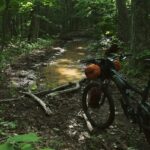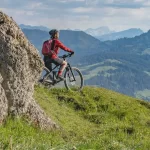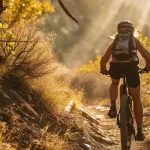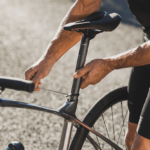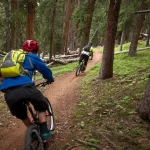Staying hydrated during exercise is crucial. Unfortunately, many overlook or pay little attention to this issue. Mountain biking, as in any physical endurance activity, an insufficient intake of water causes a serious loss of performance even up to 20% less. Water shortage is a situation that we do not realize right away. Here we give some simple and basic advice.
We’ll try to give some answers and advice in order to avoid unpleasant incidents. Nobody wants to turn their trip by bike in a day in the emergency room because of a dehydration or sunstroke.
Drinking Water is Essential
First basic rule for any sport is the knowledge of its physical needs. To understand how important hydration is in cycling, as well as during any other physical activity. For this reason, anyone doing sport, at any level, needs to replenish the loss of body fluids.

Water is the fundamental element that you will have to replace, but it is also important to consider what and how much there is dissolved. In addition to water they are lost in fact numerous other elements. The sweat is an isotonic liquid, essential to help maintain a constant body temperature, and is composed, in addition to water, from sodium and chlorine , but also magnesium , potassium and other mineral salts. For this the waters with a low dry residue (salt content) that are often advertised, are poorly suited to sports.
What and how to drink
It ‘very important to remember to drink before the sensation of thirst is present and avoid icy or hot beverages that may cause gastrointestinal problems. Normally, at rest, you should drink about two liters of water a day , remembering to hydrate even and especially between meals to neutralize and eliminate muscle waste accumulated.
During physical exertion, according to the time, the intensity and the environment in which it supports, it is necessary to take fluids at room temperature and in small sips . It ‘a good idea to drink, especially if it’s hot, every 15 minutes a quantity of less than 200 ml to avoid burdening the stomach.
Classification of beverages
The most common classification of sports drinks is based on the same osmotic pressure, comparing it with that of the plasma (which is of 280-300 mOsm / kg H 2 O):
- Hypotonic drinks – The concentration of the substances in the drink determines a osmotic pressure lower than that of the plasma . They are assimilated very quickly and are ideal if taken during exercise physical.
- Isotonic drinks – The concentration of the substances in the drink determines an osmotic pressure identical to that of the plasma . Are assimilated into the medium quickly and are ideal if taken before and during exercise physical.
- Hypertonic drinks – The concentration of the substances in the drink determines an osmotic pressure greater than that of the plasma. They are assimilated in a long time and are ideal if taken after exercise physical.
- Mineral supplements – As we understand it, in addition to water it is vital also replenish the minerals that are lost through sweating. They are active participants of multiple physiological functions of our body, and are comparable only through food and beverages we eat.

The first thing to think about is very simple – to hydrate you should drink regularly and in adequate quantity. The first suggestion then is to get ideal containers. It’s a good idea to keep in mind that you should drink every 15-20 minutes maximum. The frequency of drinking will have to be adjusted – not to forget about this you can use the very useful handset alarm functions or bicycle computer that will sound the alarm every time you will have to drink.
The sips of water to be taken will depend on the climatic situation and must take account of the intensity of effort.
How to Store Water in Backpack
During the cycling it is always important to not run out of fluids, especially if the temperatures are high and involve an equally hearty sweating.
The first thing to do is to inquire about the water supply points available on the track, to avoid carrying extra pounds. The best match for the transportation of liquids in my opinion is the use of a hydration pack with Camel Bag (plastic container with long straw) where you can store a few liters of pure water and one or two bottles to hold the minerals to sip occasionally.
Avoid putting liquids other than water in the camel bag because it might be difficult to clean and its remains of organic matter in it is easy for mold to grow. Remember, when you return from the excursion by bicycle, to wash the bottles and empty the camel bag by placing inside an object that takes apart the walls to complete drying. Occasionally wash the containers with water and a few drops of antiseptic to disinfect. Rinse everything before reuse.
The amount of liquid from the lead bicycle, as we have said, depends on several factors such as the duration, the outside temperature and by the points in which it is possible to refuel. You may need to carry around a large amount of water.
Today, in addition to the typical mountain bike or road bike water bottles, water backpacks also exist. They come in various sizes. These backpacks are characterized by the presence of the containers that can retain a variable amount of liquid. With these systems, water is always available. You drink through a straw coming out of the container and ending with a special spring-loaded device that does not get out of the water when not required.
Cleaning Water Bottles and Containers
If the water bottles have few problems, cleaning of containers in the bag is a matter to be reckoned with, in fact the inside of the bag is not easily accessible. It will be a good practice to use a can with pure water, without the addition of anything else – sugary additives, minerals or protein substances are phenomenal producers of environments suitable for the proliferation of bacteria and bad odors. In this way the container once rinsed, it can be dried and stored. An object held in the detached walls favors drying.

Another advice is to proceed from time to time to fill it with water and a few drops of antiseptic for complete disinfection. In this case you will need to remember to rinse before using it again.
Another useful tip can be to keep the container in the refrigerator. Once rinsed, fill it with water and store it in the refrigerator. This procedure is more simple. The cold is an excellent deterrent for the proliferation of bacteria and therefore the formation of unpleasant odors.
Keep in mind that there are expensive cleaning kits available (useless if you follow the advice given).
Prepping up Drinks for your Trip
The topic might seem more complex but instead is very simple. In containers you put water, pure and simple water. The addition of minerals is certainly recommended, but please always consider that the additions should always be mild. During the exercise the mineral salts should be taken when needed, so very much diluted with water.
To give you a practical example, with one serving (500 ml) of solution as Gatorade, Energade or similar drinks, you should have at least “two half-liters” to be used during the exercise. In other words, the 500 ml bottle of drinks are distributed in two flasks which then end up to fill with water. Such a drink can be completed by 4 teaspoons of maltodextrin and fructose for each bottle. It is more or less the same thing, only that fructose is sweet and maltodextrins is tasteless.
Each bottle will contribute about 140 calories, an ideal fit for a liquid to be taken during exercise.

